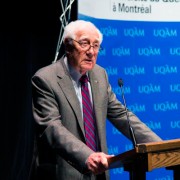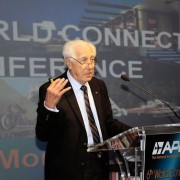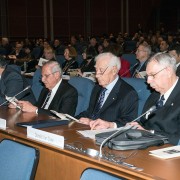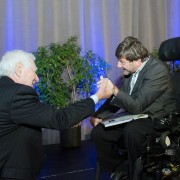APG WORLD CONNECT
October 29, 2015 – Marrakech
THE GREAT DEBATE >
“Open Skies” or “Fair Skies”? That is the question >
Moderator Pierre Jeanniot >>
Having completed their respective consolidations, the three major U.S. airlines – namely United, Delta, and American – have been reaching a new height in profitability.
The profit forecast for the current year continues to be excellent, and some concerns are beginning to appear about what is starting to look like a comfortable oligopoly.
An immunized Joint Venture involving the major players of each of the three key alliances was in place and controlling a substantial portion of the trans-Atlantic traffic.
It was now time to renew the fleet – and finally reward the shareholders.
In Europe, the Lufthansa Group and the Air France/KLM Group are hoping to finally reach an agreement with their respective unions to expand low cost subsidiaries, which hopefully will contain the erosion of their domestic/European traffic caused by Ryan Air and Easy Jet , among others.
Lufthansa had an ambitious program in place for German Wings, and the Air France/KLM Group was anxious to obtain the green light to substantially grow TransAvia.
The International Airline Group (IAG), led by British Airways, had been the first to restructure by “right-sizing” Iberia and establishing a strong presence in the low costs game with the acquisition of Vueling.
One would have expected that some new stability would emerge for the airline industry, but this was not to be the case.
The Gulf Carriers’ Hub Strategy
Exploiting a strategic geographic position – or some other specific advantages, whether economic, historical or otherwise – is nothing new.
Venice took advantage of its strategic geographic position on the Adriatic sea, and the financial strength of its bankers, to control the trade between Europe and the Middle East during the 13th to the 15th centuries.
Genoa became a competing hub, and later on Amsterdam developed a dominant position in Northern Europe.
England, a state island, felt obligated to ensure that London would become a strong naval hub.
In more recent times – and looking at the commercial aviation side – KLM was probably the first airline to build an international aviation hub in Schiphol.
KLM was quite successful at growing its market well beyond its own home base.
KLM became a 6th freedom specialist, handling traffic flows from other countries to other countries through Amsterdam.
Singapore, an island state, exploited the same strategy, driving traffic from south-east Asia to Europe through Changi Airport.
It is therefore not surprising to see that both Singapore and the Netherlands were the first to welcome with open arms, and to adhere to the U.S.A. “open skies” type of bilateral – essentially because the “open skies” bilateral further facilitated the expansion of the 6th freedom strategies.
A decade ago, the Gulf Airlines’ 6th freedom traffic was not yet very significant and did not attract much attention.
However, their growth ambitions should have been fairly obvious, given the very large quantity of aircraft they were ordering.
Last year, the three Gulf airlines – together with Turkish Airlines which is following a similar strategy – carried a combined total of 115 million passengers.
The European legacy airlines began to lose an increasingly significant share of their long-haul market to Asia, which was being diverted through the Gulf airlines’ respective hubs.
Lufthansa believes that its Frankfurt hub has lost nearly a third of its market share on routes between Europe and Asia since 2005.
Emirates and Qatar Airways now serve some 32 destinations in Europe, and Turkish Airlines operates at 84 European airports.
Those carriers are in the process of adding many services to more points in Asia, and are expected to take an increasing share of the Europe to Asia traffic.
They are also increasingly providing good connectivity through their hubs to various points in India, and in the Eastern part of Africa.
The legacy European carriers’ initial attempt to draw attention to their perceived lack of “level playing field” was unsuccessful in bringing the E.U.’s attention to the matter, perhaps because:
- These Gulf carriers were placing on order a huge amount of European-built airplanes, and
- Europe was attempting to negotiate with the U.S.A. an air bilateral agreement which was trying to be even more liberal than “open sky” and would permit expanded foreign ownership.
And thus, on the basis of “if you can’t beat them, join them”, European carriers began to look for accommodations, if only reluctantly.
- Air France/KLM declined to inject more funds into the restructuring of Alitalia, and instead tacitly accepted that, by default, Etihad would acquire a 25% commanding stake in Alitalia.
- Air France/KLM, while maintaining a much reduced position in Alitalia, developed a series of code shares with Etihad – to protect their position.
- The I.A.G. invited Qatar Airways to join “One World Alliance”, and Qatar purchased 9.99% of IAG’s stock.
- More recently, Lufthansa formed a Joint Venture with Turkish Airlines called “Sun Express” for vacation destinations in Turkey and various Mediterranean and Middle East destinations.
- The European Community had tacitly approved an investment of 49% by Etihad in Air Berlin and some 25% investment in Alitalia.
Additionally, the Swiss Civil Aviation Authority gave approval to a 33% stake of Etihad in “Darwin” which was rebranded Etihad Regional.
And then, choosing not to rely on its previous relationship with B.A., Qantas became a major partner of Emirates, choosing their hubs as the most appropriate way to connect with many European destinations.
However, having explored many of the opportunities in Europe, the Gulf carriers now turned their sights on North America.
Now they were ramping up their service to the U.S.A. – to the dismay of the major North American international carriers.
Claims of Unfair Competition
The U.S.A. coalition of airlines, a lobby group representing, primarily, the three major North American carriers – Delta, American, United, and their unions – released a document to back a report accusing the Gulf carriers of having received some 42 billion USD in assistance by their respective States over the past decades, and they alleged that this was only the “tip of the iceberg”.
Those benefits would include such things as:
- Zero interest loans – with no arrangements for repayment;
- Grants of land which could be regarded as subsidies;
- Development of massive airports, built and paid by the State, and very cheap rent facilities and landing charges;
- Low labor rates because the home state bans unions;
- Low personal and corporate tax rates to promote the growth of business.
These three carriers were pressing the “White House” and the Department of State Transportation and Commerce, to revise or terminate the “Open Skies” air bilateral agreements with the United Arab Emirates (U.A.E.) and Qatar.
They claim that the extensive government support enjoyed by the Gulf carriers provides them with unfair advantages, and distorts competitiveness.
Not all the U.S. airlines support the attacks. Fedex – a major beneficiary of the U.S. “Open Skies”, and one of the world’s largest airlines – opposes any major change to the current “Open Skies” policy.
Fedex President/CEO, David Bronczek, wrote: “These U.S. passenger carriers do not fly extensively between foreign points like Fedex does. From its Dubai hub, a gateway into Africa, Fedex flights from the U.S. crisscross with our flights from India and Asia, in order to move U.S. products into local markets.”
The U.S. Travelers’ Association and several airlines such as Alaska, Hawaiian, and Jet Blue, have also indicated their opposition to any changes, and have signed a letter defending the Gulf carriers.
The U.S.-U.A.E. Business Council asked that Delta release for public review its study of the subsidies provided by the Gulf States to their airlines, and redirected public attention to its own 2013 “Study of the Impact of Open Skies on the U.S.-U.A.E. relationship”.
This study had identified that the impact of Open Skies on the U.S.-U.A.E. relationship was 16 billion USD and 200,000 manufacturing jobs, plus some 6 billion USD in increased inbound tourism.
Who is more subsidized?
Both sides have essentially made claims that their counterpart has benefitted from unfair financial support which has been distorting competition.
The Gulf carriers have responded vigorously to the U.S. major airlines’ allegations. Emirates has published a huge report which indicates that, contrary to these allegations, Emirates received only a total of 218 million US dollars in capital investment and has returned some 3.8 billion US dollars in dividend to the shareholder, while the U.S. carriers have received benefits of some 100 billion US dollars.
Ethiad has estimated that American Airlines, Delta, and United Airlines received 71.48 billion US dollars in government sanctioned “benefits and concessions”, which allowed the U.S. carriers to quickly progress from the “edge of bankruptcy” to being today among “the industry leaders”.
Referring to the current “Open Sky” air bilateral agreement between the U.S.A. and the Gulf States, Emirates points out that under the current agreement:
- A capacity freeze would be a breach of the current bilateral.
- Article 11 of the US/UAE Open Skies agreement – dealing with fair competition – contains no reference to subsidies.
- Article 13, which deals with artificially low prices, does not mention any direct or indirect government subsidies or support.
- Neither party shall take unilateral action.
Emirates currently serves ten U.S. destinations, and still plans to extend its operation to some twenty U.S. destinations in total.
European Majors Airlines echo their U.S. Counterparts
The U.S.A. Open Skies discussion had reached a stalemate on the question of foreign ownership some time ago, with the U.S.A. refusing to allow more foreign ownership.
In fact, the U.S. airlines appear quite comfortable with the current status quo, and their unions find themselves on the same page.
Thus no one in Washington wanted a change at this time – but the dramatic rise of the Gulf carriers was having an impact.
Stimulated by the position taken by the three major U.S. carriers with respect to the Gulf airlines, some European carriers decided to go back on the offensive, and asked their governments to intervene.
Both France and Germany’s Ministers of Transport have called for the European Commission to act in order to restore “fair competition with the airlines of the Gulf”, and called on the E.U. to adopt a common strategy to “put an end to those unfair practices”.
Austria, Belgium, the Netherlands, and Sweden supported the initiative.
The European Cockpit Association is calling the rise of the Gulf carriers “an unintended consequence of liberalization”.
The request is now for “fair skies” … not uniquely “open skies”.
The European Union will request a new mandate from Member States to the European Commissioner, Violeta Bulc, to negotiate with the Gulf Cooperation Council on Aviation Competition.
Some European airlines are asking for Europe to withhold traffic rights from Gulf carriers until further negotiations and a new Agreement is achieved between the E.U. and the Gulf States.
They are also requesting that financial support for European “quasi subsidiaries” such as Air Berlin and Alitalia – where Etihad holds a major stake – be subjected to European competition law.
The E.U. and the Gulf States have agreed to hold a round of talks by the end of 2015.
Strains on Alliances and Associations
The current situation has introduced some strained relations in both North America and Europe.
Alitalia and Air Berlin have terminated their membership in AEA. Both are affiliates of Etihad.
The International Airline Group (IAG) also withdrew its membership in AEA, citing significant differences in opinion.
Having left AEA, the International Airlines Group has now become a member of ELFAA – the European Low Fare Airlines’ Association.
Encouraged by important membership gains earlier this year, particularly the addition of the International Aviation Group, ELFAA went on a renewed offensive
- Calling for rejection of the air traffic control price hike proposal;
- Requesting improvements in airport charges;
- Condemning the proposed extension of the Intra-EU only scope for E.T.S. (Energy Trading Scheme).
Initiative by the five largest EU Airline Group
The five largest European Airline Group – Air France/KLM, EasyJet, IAG, the Lufthansa Group, and Ryanair – met last summer and agreed to work together to lobby for the development of a new aviation strategy for Europe in response to the request for input by the new E.U. Transport Commissioner, Violeta Bulc.
These five airlines between them carried a total of 420 million passengers in 2014, accounting for half of the passenger journeys in Europe.
They also agreed that to have six airline organizations representing the airline industry in Brussels was not the most effective way, and agreed to explore possible forms of future representation, yet their action was ‘de facto’ creating another airline organization lobby group.
The five airlines identified a number of measures which would support the Commissioner’s objectives to enhance the competitiveness of the European air transport industry, support the growth of jobs across Europe, and help consumers by providing more flights and lower prices.
The group of five proposed the following:
- Develop a simpler, more efficient regulatory structure;
- Look at lowering the costs of the E.U. airports, and at ensuring that monopoly airports are effectively regulated;
- Deliver reliable and efficient airspace by reducing the costs of ATC providers, and ensure that ATC strikes do not cause disruptions;
- Stimulate the economy by removing passenger taxes – and unreasonable environmental taxes.
The group confirmed their support for several key principles – the most important, of course, being commitment to safety and safety standards.
They also reaffirmed their opposition to the provision of State aid to airlines and airports, and their support for balanced consumer rights.
Airport Council International -Europe
Referring to the ACI Europe 2015 Airport Industry Connectivity Report, ACI Europe at its last annual meeting stressed the need for the E.U. to place connectivity and consumers at the very heart of its new aviation strategy.
Adding its voice to the current debate, the President of ACI Europe stated: “Open Sky and fair competition need to go hand in hand, but airport and tourism organizations do not regard public financing of airport infrastructure, start-up aid for airlines, and more favorable fiscal regimes as necessarily involving unfair competition, but rather as legitimate economic development policy chosen mostly by the Gulf States”.
What about consumer interests?
These do not appear to be a central preoccupation in the current airline concerns. The requests for a “level playing field”, and for “fair and equal opportunity” to compete, do not seem to refer to the consumer.
The original force behind aviation deregulation was the need to satisfy consumer pressure. The consumers were clamoring for more choice and better prices, and it could only be satisfied if there was more freedom to participate in the market and allow the offering of different products and prices.
The growing importance of consumer interests replaced the need to protect the interests of national airlines.
But there are no reasons as to why the interest of the consumers and that of each local airline would not coincide!
The Gulf carriers took advantage of their geographic position between Europe and the many emerging economies, primarily in Asia, and the availability of new long-haul and efficient large airplanes.
The Gulf carriers have introduced a level of customer service which corresponds to their expectations – but would that have been commercially possible without financial support from their States?
Open Skies bilaterals were successful in opening up new markets – promoting competition and consumer choice.
Using the particular advantages of strategic geographic position and modern long-haul fleets, the Gulf carriers have provided European consumers with a convenient, one-stop service from Europe to many existing and new destinations primarily in Asia, but not uniquely.
The Gulf carriers are probably taking market share from the European carriers, but they are also most likely stimulating the market, and stimulating overall market growth.
Are the European and North American customers flying on Gulf carriers being subsidized indirectly by the Gulf States – if not by lower prices, by offering higher quality?
And would that be considered predatory?
Have the European carriers, previously owned by their respective States, been also in the past heavily subsidized as well?
IAG and British Airways would appear to have come to a way towards living with the situation.
What about Africa?
The question of “Open Skies” is also an important subject for other regions of the world, and specifically for African aviation.
The Yamoussoukro Declaration, signed in 1999, pledged its 44 signatories to establish an “Open Sky” regime across the continent.
But it was really never implemented.
Clearly, not all African governments see aviation as a national asset – nor a strategy of economic development, as is the case for the Gulf States.
Despite this apparent lack of interest by African nations, the latest passenger forecast by IATA for Africa nevertheless predicts that the Continent should enjoy the second highest rate of growth of the various regions, at 4.9% per annum.
But still today, some 80% of the intercontinental traffic between Africa and the rest of the world is controlled by non-African carriers.
The African Union has recently agreed on a Common African Civil Aviation Policy which proposes to adopt a united position in its dealings with the E.U.
However, this proposal is not binding on its members – and has not made much progress.
Meanwhile, there are a few hopeful signs.
Senegal has made a formal offer to South Africa suggesting that South African Airlines and Senegal Airlines take an equity stake in each other, and work towards a common restructuring program.
In December 2006, Morocco decided to join Europe’s Common Aviation Area. This led to a dramatic increase in traffic volume, with the European “low cost” airlines as Ryanair and EasyJet aggressively competing to increase their share of this market.
Morocco had signed an Open Sky with the U.S.A. in 2001, but it did not have a major impact on traffic growth.
Morocco now attracts more than 15 million visitors annually, which is a major success for the tourist industry. However, Royal Air Maroc considers that some of these “Open Skies” agreements are unbalanced and unfair, as they do not feel they have an equal opportunity to compete.
With the population of Africa expected to increase by 50% over the next 20 years, the potential for a large increase in the Middle Class is excellent.
If it finally comes into its own, Africa could follow a similar pattern to that which we have seen in Southeast Asia during the past 20 years.
But today, in most parts of Africa, we may have a case of no “Open Sky” … and no “Fair Skies”!
“Open Sky” in Asia
A 10-member group of ASEAN and developing nations plan to achieve a single aviation market by December 31, 2015.
This is part of a broader ambition to create a comprehensive free-trade zone which, however, would not go as far as creating a border control free market such as the Schengen zone in Europe.
To become effective, the agreement requires a minimum of three States’ signatures.
And given the aviation policies of a few of those nations, this is likely to be achieved fairly quickly.
However, the “Open Sky” agreement would, of course, liberalize air transport and services between those signing countries only.
Any country having some concerns about the unequal competitiveness of their aviation industry may ask for a moratorium on various aspects of the Agreement.
Looking at the membership of the ASEAN nations` group, there are giants like Singapore Airlines, Thai Airlines, and Malaysian which have bilateral feeder agreements with major airlines all over the globe, and which could readily benefit from such “Open Sky ASEAN Agreement”.
On the other hand, many smaller airlines such as Philippines Airlines, Garuda, and Lion Air would likely be more fearful.
As such, the implementation of the “Open Sky Agreement” over the 10-member group of the ASEAN nations will be progressive.
Intra-ASEAN air travel will increase – but only gradually.
What about China?
While attention is being focused on the Gulf carriers, China’s airlines are in the process of overtaking the U.S. airlines on the China-North American market.
In summer 2015, China’s airlines for the first time are expected to carry more passengers than their U.S. counterparts between China and the U.S.A.
Their rapid rate of growth is expected to continue, and the increasingly dominant position of the Chinese airlines is likely to impact on the next round of bilateral air negotiations.
It would not be surprising to see the U.S. position no longer favor a full “Open Skies” Agreement, reflecting on their experience with the Gulf carriers, although the consumers’ associations and tourism bodies would continue to press for more liberalization.
The same situation is occurring on the China-Europe market.
The number of seats – weekly, one-way in August of 2015, according to the OAG – flown by Chinese carriers between China and Europe now exceeds the totality of the capacity offered by the European airlines combined.
And the rate of growth in capacity offered by the Chinese carriers continues to rank in the double and exceed by a factor of three the rate of growth of European airlines in that market.
This summer, 22 airlines connected China and Europe. Some 14 Chinese airports have direct links to Europe, and that number is expected to continue to grow.
In agreeing to more frequencies between China and Europe and the U.S.A. , should the European Community and the U.S.A. be concerned that the Chinese carriers are heavily supported by their governments?
Placing limits on “Open Skies” Agreements on the basis of government support – or `subsidies’ – is a 2-edged sword!
In North America, the cargo airlines – Fedex and UPS – are enjoying the world-wide benefits of Open Skies Agreements, and any retaliation imposed by the Gulf States could be very damaging to their operations.
On the question of fairness, what attitude should be taken with respect to the “fly American” directive which has long been a contentious issue?
This is clearly a policy which gives U.S. carriers a substantial financial advantage.
The question of expanding “open skies” with China was considered very important to the major U.S. carriers.
China’s airlines are hugely subsidized by Beijing, and if subsidies are inconsistent with “open skies”, expanding U.S. flights to China may not be possible – and neither would the lucrative joint venture over the Pacific.
Would limiting competition over the Atlantic trigger a re-opening of the approval of joint ventures?
One thing is clear. Governments, both in Europe and in U.S.A., have been asked to review air bilaterals with the Gulf States.
International travel and tourism is a major engine of economic growth.
The “Open Sky” type of bilateral has greatly facilitated – and accelerated – that growth. But, considering the current questions
- What is fair airline competition?
- What is fair for each country?
- What is fair for the consumers?
the “Debate on Fairness” may prove most interesting.
Thank you








